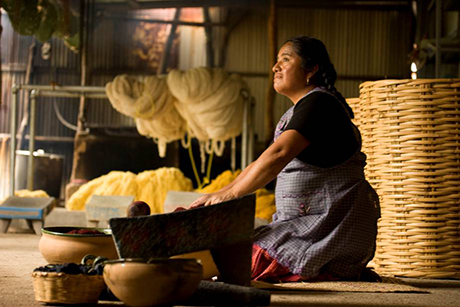From the tiny cochineal cactus insects that dye fabrics a brilliant red to the delicate intricacies of tapestry rug weaving in Teotitlán, the documentary “Woven Lives” chronicles ancient textile techniques that serve as a connective thread uniting cultures throughout Mexico’s region of Oaxaca.
The documentary, created by University of Wisconsin-Madison Associate Professor Carolyn Kallenborn, was presented at the Marvin Center Amphitheatre on Friday as part of the D.C. Environmental Film Festival, which partnered with The Textile Museum for the screening.
This year’s festival runs until March 30 and features more than 200 films that address the theme of “Our Cities, Our Planet,” examining challenges in urban and natural environments. Tom Goehner, curator of education at The Textile Museum, explained he was drawn to “Woven Lives” because of its unique story and promotion of ancient, sustainable traditions in Mexico.
Ms. Kallenborn began working in Oaxaca while teaching at the Kansas City Art Institute. She stayed in regional villages, observing and learning the communities’ art and culture. Hoping to capture the story of local artisans and their textiles, Ms. Kallenborn received a research grant from the University of Wisconsin-Madison and additional support from The Textile Museum of Oaxaca to create a film project.
“I was really interested in the way the art-making, the community life, the history, the land and the culture were all interwoven,” she said.
Her film traces the customs of the indigenous Zapotec people, and how their techniques have been passed down among generations. It delves into particular communities of Oaxaca, like the village of Santa Ana del Valle, where artists achieve richly colored yarns using natural plants, and Santo Tomas Jalieza, where the oldest pre-Hispanic weaving styles are used.
Other segments of the documentary explore silk weaving in San Pedro Cajones, home to the Bienhi Cooperative made up of several families who united to produce silk textiles and generate income for the village. In Mitla, weavers speed through cotton fabric on fly shuttles, producing more than five meters an hour.
Ms. Kallenborn explained that throughout the making of the film, she was able to observe the differences of each village.
“I was regularly delighted at the ingenuity of how different individuals approached their work and their lives. It was also amazing to see just how fast their hands can work, as they sit relaxed and chatting. There was a wonderful variety of personalities and techniques that played out in each particular village or household,” she said.
Her film is being shown at several colleges and universities in Oaxaca, and she has been surprised to find that not everyone in the region is aware of what other communities are doing. She hopes that all viewers, particularly those in the GW community, take away an awareness of the complexity of indigenous Mexican culture, an appreciation for the artistry of handmade textiles and an understanding of the distinctness of each village and each artisan. She also added that the film offers Americans a glimpse of a different type of work-life balance, culture and economics.
Mr. Goehner said “Woven Lives” is an example of the diverse events that The Textile Museum will offer GW students, staff, faculty and neighbors once it comes to Foggy Bottom.
“This is the kind of programming we hope to continue in the new museum, and we hope to open these events up to GW and the broader community as we move forward,” he said.


